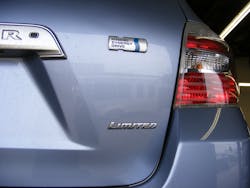Safety first when working on high-voltage vehicles
Hybrid electric vehicles, or HEVs, use high voltages that will cause injury if the manufacturer’s safety procedures as well as general shop safety procedures are not followed. For this reason, it's strongly suggested technicians take at least an introductory hybrid training course that includes training on approved safety procedures.
As with all vehicles you must follow approved safety procedures by using approved personal protective equipment and manufacturer-specific repair information. When working on hybrid electric vehicles’ high-voltage systems, additional items may need to be utilized such as Class 0 high-voltage insulated gloves and CAT III 1,000V insulated tools.
Currently, OSHA has not mandated a specific recertification interval for high-voltage protective gloves used on hybrids, but the standard in the high-voltage electric industry is to have gloves recertified every six months and to start using them within one year of the certification. It is also recommended that you test the gloves for leakage every time you use them.
This is accomplished by blowing into the gloves (similar to a balloon) and squeezing or rolling them to see if any air leaks out. If there are any air leaks or signs of cracking DO NOT USE the gloves and replace them prior to starting work on a high voltage system.
Using a CAT III 1,000V DMM along with CAT III test leads is also required. It is also a very good idea to advise all other technicians working in the shop that you are working on a high-voltage system and they should either wear approved safety gear or stay out of the workspace.
Use of repair information sources and following all warnings is critical to assure you are safe when working on all hybrid systems. Since HEVs use a regenerative braking system which assists in not only recharging the high-voltage batteries but also has the effect of slowing the vehicle, make sure that high voltage is not present in the part of the system you will be working on and take the necessary precautions if it is.
About the Author

Barry Hoyland
Barry Hoyland has been in the independent aftermarket for more than 45 years as a technician, technician instructor, shop owner, and shop management consultant. He owned and operated a successful Southern California automotive repair center that offers complete auto care and specialized in emission and diagnostic services for over 28 years. Hoyland also owned a company that modified vehicles to perform as emergency response units and mobile command centers, incorporating high-end electronic components into today’s vehicles. Hoyland has experience with all size and types of vehicles including traditional gas, hybrid electric, alternative fuel, and heavy duty diesel trucks.
Hoyland has provided consulting services for many automotive shops, fleets, and government agencies in order to improve their operational efficiencies.
In addition, he has worked with many NHRA drag racing teams as a crew chief on supercharged alcohol and nitro-methane fueled cars and currently serves as a crew chief on a Top Alcohol Funny Car, a Nostalgia Funny Car, and a Nostalgia Alcohol Dragster
Hoyland holds certifications in ASE: A1, A6, A8, and L1, MACS 609, maintains a California Advanced Emission license, and a CDL with endorsements for double and triple trailers, tankers, and HazMat.
When he is not helping to run a shop in the Pacific Northwest, Hoyland travels across the U.S. as an instructor of technical and shop management courses, many of which he has developed.
